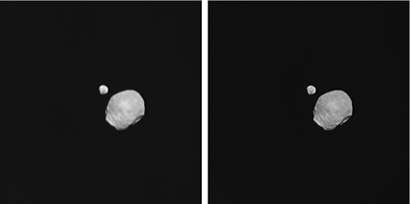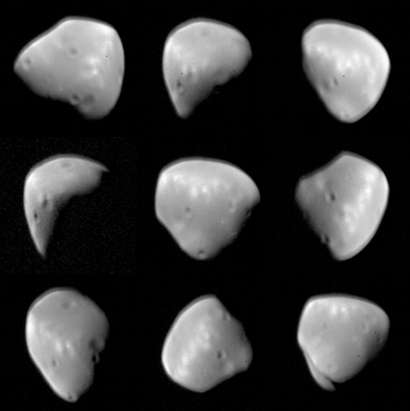Where is Mars's moon Deimos?

(Phys.org)—Despite more than a century of observations, the orbit of the Martian moon Deimos is still not known to a high degree of accuracy, but a new study using images taken by ESA's Mars Express orbiter has provided the best orbital model to date.
135 years have passed since Asaph Hall discovered Phobos and Deimos, two small companions of the planet Mars. Since that time, the satellites have been imaged innumerable times from the Earth and from spacecraft, including recent measurements by the panoramic cameras on the Mars Exploration Rovers and instruments on the Mars Reconnaissance Orbiter.
Although the orbit of the inner moon, Phobos, has been calculated to an accuracy of less than 1 km, the path of more remote Deimos is less well known. In order to improve the orbital models for Deimos, researchers from Germany and Russia have developed a new technique which compares images taken by Mars Express.
Deimos follows an almost circular, near-equatorial orbit at a mean distance of 23 458 km from the centre of Mars. Unlike other Mars orbiters, Mars Express follows an elliptical, near-polar orbit which occasionally enables it to obtain excellent views of Deimos.
Between July 2005 and July 2011, the spacecraft made 50 approaches to Deimoas, passing within 14 000 km of the satellite. The closest approach was in March 2011, when the orbiter closed to a range of about 9600 km. However, since the moon is tidally locked to the planet, the spacecraft largely observes the same Mars-facing areas on its surface.
136 images were acquired at different places along Deimos' orbit by the Super Resolution Channel (SRC) of the High Resolution Stereo Camera (HRSC). The SRC is a 1K × 1K CCD-framing camera which is designed to focus on features of interest within the HRSC image strips, when imaging Mars. In comparison with the HRSC, it magnifies features in the image by a factor of about four. In the case of Deimos, the framing images are ideal for astrometric (positional) measurements of the small Martian satellite.
Any astrometric measurement requires good knowledge of the observer's location and viewing direction. In the case of the observations from Mars Express, the position of the spacecraft and the direction in which the camera was pointing were derived from navigational data provided by the European Space Operations Centre (ESOC) in Darmstadt, Germany.

The attitude of the spacecraft (and the pointing of the body-mounted camera) is measured by using two star trackers and three laser gyroscopes. The SRC pointing was verified and corrected for by measuring differences between the observed and predicted positions of background stars in the images. Owing to the SRC's narrow field of view, usually one or two faint stars per image could be observed. The precise positions of these stars are known from catalogues based on data returned by ESA's Hipparcos satellite.
In a paper accepted for publication in Astronomy & Astrophysics, the researchers describe how they used a new astrometric technique, in which the centre-of-figure of non-spherical Deimos was determined by fitting the predicted limb (visible edge) of the satellite to the observed limb.
Over a period of 1.5 to 3.5 minutes, a sequence of seven or eight images was acquired as Deimos moved across the field of view. In all cases, the first and the last image were taken with long time exposures (about 500 ms) to capture faint background stars (magnitudes ranging from 3.4 to 8.8). From the five or six short-time exposures, two to four images usually included Deimos.
"From 50 sets of observations, we fortuitously had nine in which stars were sufficiently bright to be seen in all images," said Andreas Pasewaldt, a PhD student at the Institute of Planetary Research in Berlin, lead author of the paper. "We obtained a set of spacecraft-centred Deimos coordinates with accuracies between 0.6 and 3.6 km.
"Using a shape model, together with nominal data on Deimos' position and rotational state, we predicted the limb that would be observed from the spacecraft. This limb was projected onto the SRC image, and then fitted to the observed limb during a series of manual and automated steps. This eventually gave us the precise position of the centre of figure for Deimos.
"Comparisons with current orbit models indicate that Deimos is ahead of, or falling behind, its predicted position by as much as +3.4 km or -4.7 km, depending on the chosen model. The data obtained by our 'limb fit method' should considerably improve the models of its orbit."
There is considerable interest in the orbital tracking of the Martian moons. Phobos, moving deep within the gravity field of Mars, is strongly affected by tidal interaction with the planet. This will eventually cause the moon to crash into Mars or break apart, creating a ring of debris. In contrast, Deimos is far enough from Mars to take more than one Martian day to complete each orbit, so it is spiralling slowly outwards.
Improved knowledge of their orbits will also shed new light on the history of the satellite system. Such knowledge is particularly important in the interpretation of gravity field data, acquired during very close flybys. This enables the researchers to model the interiors of the moons and put constraints on their origin.
"It is unclear whether they are asteroids that were captured by Mars or whether they coalesced from a ring of material that formed around the planet after a large object collided with Mars, although the latter scenario seems to be favoured in recent years," said Olivier Witasse, ESA's Mars Express project scientist. "Simultaneous modelling of both orbits may provide strong constraints on the origin and evolution of Phobos and Deimos."
"Better orbital models are also important for future satellite missions, such as automated sample returns currently being studied at ESA, when high navigational accuracy is needed."
More information: dx.doi.org/10.1051/0004-6361/201118603
Journal information: Astronomy & Astrophysics
Provided by European Space Agency




















